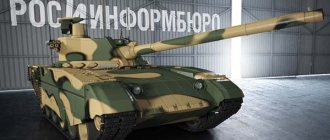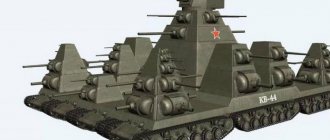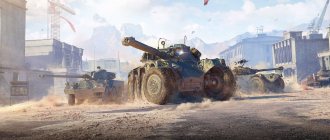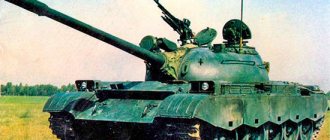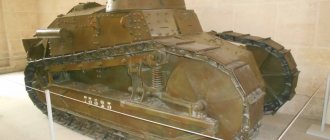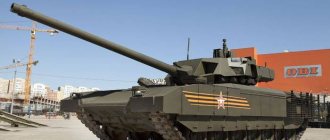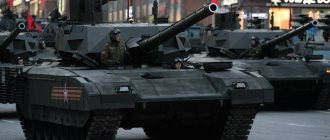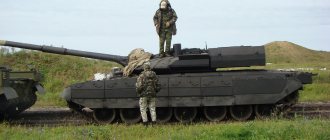As they say: “Tanks are not afraid of dirt.” This expression perfectly characterizes such a powerful machine as a tank. The tank is not afraid of any obstacles; you can not only feel completely safe in it, but also, in case of danger or enemy attack, defend yourself with the help of military artillery. It is a kind of multifunctional machine.
M1A2 Abrams
A new generation tracked tank from the American manufacturer General Dynamics Corporation has been in service with the US Army since 1992 and is actively purchased by other countries (Poland, Egypt, Australia). The model is manufactured with the latest technology and has a computer fire control system (FCS).
Characteristics:
- weight - 62.1-70 tons;
- crew - 4 people;
- layout - classic;
- length / width / height - 7.9 + 2 / 3.6 / 2.4 m;
- active / dynamic protection - AN-VLQ-6 MCD / ARAT;
- rifled tank gun - 120 mm M256 (42 rounds of ammunition);
- machine gun - 12.7 M2 (Protector RWS);
- gas turbine engine - AGT-1500, 66.8 km/h;
- laser range finder, thermal imager;
- commander's panoramic sight, gunner's sight with stabilization in 2 planes;
- computerized on-board equipment with radio communications and Navstar-GPS navigation;
- price - 5-6 million dollars.
Pros:
- improved BIUS navigation;
- armor can withstand M829;
- the ammunition is in a protected compartment;
- 390 km without refueling;
- rate of fire (10-12 rounds per minute).
Minuses:
- weak onboard protection;
- some models do not use self-guided munitions (MRM);
- 1 person must load the gun.
Seven best tanks of our time
Western journalists, like politicians, are haunted by the idea that Russia was able to create tanks that are superior in quality to their Western counterparts. Thus, Forbes magazine, in a rather voluminous article, made a comparison between the main mass tanks of Russia, Germany, the USA, China and France; accordingly, the following samples were subject to critical assessment: T90, Leopard-2, M1A2 SEP V2 Abrams, MBT-2000 and AMX- 56 Leclerc. For the sake of fairness, let’s also add the British Challenger 2 tank to this list and compare these six samples in order to determine the true leader. Let’s reduce the evaluation principle to the simplest: we compare the technical characteristics of vehicles, defense systems and weapons, the cost of their production, the effectiveness of combat use, demand on the global arms market, and based on the totality of these data, we can determine the best machine. It is perhaps also worth adding the Israeli tank Oshlbd (Merkava) to this list.
Of course, it would be possible to consider other excellent examples of tank construction, such as the Japanese main tank Type-10 or the South Korean main tank K2 Black Panther, but given their relatively low production and the lack of examples of combat use, we will abandon consideration for now these candidates in the ranking for the title of the best tank in the world. There is no point in considering the Russian T14 Armata tank yet, since this model has not yet been adopted for service.
ABRAMS AND T90
The Western media almost in unison praise the merits of the American M1A2 SEP V2 Abrams tank, calling it the pinnacle of technical excellence in world tank building, well, let these praises remain on their conscience, let’s move on to the facts. First of all, it is worth noting that this tank is an old development (serial production began on February 28, 1980), which has been modernized many times. But overall the car has proven itself well. It is equipped with a 1,500-horsepower AVCO Lycoming AGT-1500 gas turbine engine; with a combat weight of 64 tons, this vehicle can reach a maximum speed along a prepared path of up to 67 km per hour, over rough terrain up to 30 km/h with a cruising range of 426 km. Specific power – 23.8 hp. per ton. The tank is well protected, its frontal armor is 650 mm thick, in addition to its own composite armor, it is protected by additional panels and has active and dynamic protection. The vehicle is equipped with a panoramic sight, a thermal imager, a laser range finder, a global positioning, control and communication system; high-resolution liquid crystal color displays (which display all the necessary information in digital and graphic forms) allow the commander to see the battlefield. The rangefinder is capable of determining the distance to the target to be hit, up to almost 5 km; the main sight is equipped with a stabilizer.
The tank is armed with a 120 mm M256 smoothbore gun (licensed version of the Rheinmetall Rh-120 made in Germany), and one 12.7 mm M2HB and two M240 7.62 mm machine guns. The tank's 120 mm gun ammunition, in addition to other ammunition, includes an M829A3 sub-caliber projectile with a depleted uranium core; its maximum effective range is 4.4 thousand m; at a distance of 2 km it penetrates 720 mm armor. The gun is loaded manually; the tank has a crew of four people. Western experts clearly overpraised this tank. In Iraq, in the current war, jihadists managed to knock out Abrams with RPG-7s, and this is already ridiculous. Poorly armed Yemeni guerrillas, the Houthis, managed to destroy about 20 Abrams tanks.
How can the Russian main tank T90 respond to all of the above? Let’s consider its modifications T90SM and T90AM. The vehicle is equipped with a V-shaped 12-cylinder liquid-cooled diesel tank engine with turbocharging V-92S2F with a power of 1130 hp. With a combat weight of 48 tons, the tank is capable of speeds of 65–70 km/h on a prepared road and up to 45–50 km/h over rough terrain. The ratio of tank weight to engine power is 24 hp. per ton i.e. better than the M1A2 SEP V2 Abrams. The track pressure per unit surface area of the T90AM is 10% lower than that of the American tank, and accordingly the cross-country ability of the Russian vehicle is higher.
The tank is equipped with a panoramic sight, a thermal imager, modern control systems, navigation, internal and external communications, and surveillance. At the disposal of the crew commander of the Kalina control system with an integrated combat information and control system of the tactical level, a high-resolution liquid crystal color display (all the information necessary for the commander is displayed on it) allows him to monitor the combat situation. The target firing range of OFZ shells is up to 10 km. Guided ammunition allows you to hit targets at a distance of up to 5 km, ATGMs reliably hit the enemy at a distance of up to 3 km.
This combat vehicle is superbly protected. The thickness of the composite armor in the frontal part of the hull is 750 mm, the turret is 950 mm. The tank's ammunition is located in a separate module, which significantly increases the survivability of the crew if it is hit by a shell and detonates all of the ammunition. In addition to its own armor, the tank has additional screens, active and dynamic protection systems. The modern modular third-generation dynamic protection system “Relikt” is too tough for the vaunted American projectile with a uranium core M829A3, so the Yankees are urgently looking for a new solution.
The armament of the T90AM tank is also impressive: a smooth-bore 125 mm 2A46M-5 cannon with automatic loading and a coaxial 7.62 mm PKTM machine gun, as well as a 7.62 mm UDP T05BV-1 anti-aircraft gun. The tank has a crew of three people (no loader). The T-90 has demonstrated exceptional reliability in the current wars in Iraq and Syria.
AMERICAN VS RUSSIAN
Since these tanks have not yet met on the battlefield, let's try to analytically assess the chances of victory for each. Undoubtedly, Abrams tanks have a rich track record and they performed well in the 1991 and 2003 US wars against Iraq. In both cases, Saddam Hussein’s tank forces were equipped with Soviet combat vehicles of the unmodernized T-55, T-64, T-72. In addition, Iraq at that time did not receive any consumables, spare parts, or ammunition from Russia, and the main factor of unreliability was the Iraqi crews, mainly because of this it was not difficult for the Americans to fight with Saddam Hussein’s tanks with virtually no losses. That is, this combat experience does not mean anything; the Yankees have never met Russian crews or modern Russian tanks in battle. Moreover, we must take into account that the Abrams fought only in warm climates, on flat, very slightly rugged, flat terrain. Experts believe that in the climatic and relief conditions of Russia, especially in winter, this “miracle machine” most likely will not be able to fight at all. The Germans already had to admire their tightly stationary vehicles on frosty days in the battle of Moscow in December 1941 - January 1942. Then, the technical parameters of the T-90AM leave no chance for the Abrams tank, both in the M1A2 SEP V2 modification and in the M1A2 SEP V3 modification. And the main victorious force in battle is the Russian soldier, Russian tank crews, who confidently demonstrate high combat skills. The new Russian T14 Armata tank is approaching, which in all respects leaves the Abrams far behind. The Pentagon has already sounded the alarm and is firmly raising the question of financing a new tank project with the Senate. Even if they manage to persuade the senators, America will still be at least a corps behind in the tank race. The Pentagon lags behind the Russian military department in operational skills; it is worth noting that the Americans do not have historical combat experience in mass tank battles, or experience in waging “big” wars either.
You can also take into account the fact that these days Abrams tanks in Iraq and Yemen are not performing well. But in this case there are two nuances: firstly, these are old cars, and secondly, they are driven by “armless” Arab crews.
LEOPARD 2
The German masterpiece of modern tank building, Leopard 2, is a good, solid tank, but due to its heavy weight it will be very difficult to fight on Russian terrain, except perhaps only along roads. It seems that, mindful of their stunning defeat on the battlefields of World War II in the East, the Germans do not even dream of considering Russia as a possible theater of operations (theater of operations). In the current Syrian war, Leopard 2 was used by Turkish troops during Operation Euphrates Shield; admittedly, it did not behave entirely successfully in a combat situation and generally received a negative assessment from experts. Again, a caveat must be made here; Turkish crews fought in these tanks in Syria; perhaps the Germans, under the same conditions, could have rehabilitated their Leopard 2. In fact, Germany is an unsurpassed leader in mechanical engineering. This project may be over 40 years old, but in its modernized form Leopard 2 looks very impressive. The weight of the vehicle in full combat gear reaches almost 70 tons, the armor is multi-component, additional protective screens are used, as well as dynamic protection systems. The tank is equipped with an automatic fire-fighting system. It has a 12-cylinder diesel V-twin engine MTU MB 873 Ka-501 with a power of 1,479 hp. or MTU MT883 with 1,650 hp. The maximum speed of this car on prepared roads is 68 km/h, and on rough terrain 30 km/h. The maximum range is 320 km. But in Russian off-road conditions, this monster can stand firm, especially in the bitter cold of Russian winters.
The Leopard 2 is armed with a smoothbore 120 mm Rheinmetall L55 cannon (manually loaded) and two 7.62 mm MG3A1 machine guns. The DM-53 anti-tank projectile with a warhead in the form of a tungsten core is capable of penetrating 750 mm of armor at a distance of 2 km, an Israeli-made LAHAT ATGM, which is included in the tank’s standard ammunition? hits targets at a range of up to 6 km. Leopard-2 is equipped with the German EMES 15 fire control system, panoramic sight, laser rangefinder, thermal imager and other equipment, including modern navigation and surveillance communication devices. The crew of the car is 4 people. For the Western European theater of operations, the tank is ideal.
Again, this tank clearly should not meet the T90AM on the battlefield; the Leopard has little chance of emerging victorious from this battle, and its vaunted defense is powerless against modern Russian anti-tank weapons.
MBT-2000 AND AMX-56 LECLERC
The main Chinese tank MBT-2000 is deservedly considered a satisfactory example in the comparative table of world tank building. Its technical capabilities, perhaps, should be compared with the T-72B, while the T90AM is inferior in all respects. Although the MBT-2000 is the most popular tank in the People's Liberation Army of China (PLA), it was originally created to capture the global tank market. This example is produced under license by Pakistan under the name Al-Khalid. The vehicle does not yet have a widely known combat history, just as the Chinese army does not have historical experience in conducting massive tank battles. It is unknown how these machines will behave in Siberian frost conditions. Currently, new MBT-3000 (VT-4) tanks are entering service with the PLA, however, this model is also aimed at the international market in the future. According to the stated technical characteristics, it is comparable to the T90AM, but one can only guess what this vehicle will be able to demonstrate on the battlefield. There is no complete certainty that the PLA command does not at all consider tanks as an effective force for modern and future wars. Unlike Russian and German tank builders, who produce all the components themselves, the Chinese supply many parts of their combat vehicles from abroad; the main components are purchased in France.
The AMX-56 Leclerc tank is another proof of the ambition of the French. They could well get by, like other countries of continental Western Europe, with the German monsters Leopard 2 or American Abrams. But no, Paris goes its own way in everything, despite the financial costs. This vehicle was mass-produced for 15 years starting in 1992, currently 406 tanks are owned by the French army, and 388 are in service with the UAE military. The weight of the machine reaches 54.6 tons. Its 8-cylinder V-shaped diesel engine produces 1500 hp. allows the tank to accelerate to 71 km/h on a prepared road and up to 40 km/h on slightly rough terrain and provides a cruising range of 550 km. I’ll note right away that this tank has not been tested in Russian conditions and, I dare say, it will not prove itself here, just like other foreign models.
The AMX-56 is protected by modular-type composite multi-layer armor; the tank is designed so that the sloping frontal armor will meet a 700 mm thick anti-tank projectile in a direct hit. This Leclerc does not have dynamic protection; the French rely on the design of their armor. The communication, control, surveillance and targeting system are combined into a single system, the tank is literally crammed with electronics, here is a full set of them, including a central computer, the tank’s control system is integrated into the control system. This car is comfortable for the crew.
The AMX-56 is armed with a CN-120-26 smoothbore gun, which has two stabilizers, and the crew has at its disposal a thermal imager, a rangefinder, a combined gunner's sight and a panoramic commander's sight. The AMX-56 tank's gun is equipped with an automatic loader. The performance characteristics of this gun are comparable to the characteristics of the German Rh 120 smoothbore tank gun; the ammunition of the guns of the Abrams and Leopard tanks is suitable for the French CN-120-26 tank gun. The Leclerc's additional weapons are machine guns: M2HB-QBC 12.7 mm caliber and F1 7.62 mm caliber. The crew of the AMX-56 Leclerc is three people. The tank is not bad, it has proven itself well in combat operations in Yemen, but again it is hardly suitable for a war in the Russian climate and landscape.
"MERKAVA" AND CHALLENGER 2
The Israeli Merkava tank ten years ago was considered almost one of the best in the world, but now it is rated much more modestly. Despite the fact that the tank is very heavy, its weight reaches 70 tons, the armor of the Merkava, whose thickness is equivalent to 750 mm, is not effective; it will not withstand modern armor-piercing sub-caliber projectiles. KAZ Meil Ruach (“Air Cloak”) is used as active protection. In battle, these vehicles do not perform at their best; this is also due to the poor training of Israeli tank crews, but this is mainly due to the technical shortcomings of the tanks themselves. It is known that the Russian Kornet ATGM terrifies Israeli tank crews. "Merkava" is produced according to the principle from the world one by one: 28% of components are foreign-made. The Merkava-4 modification has a 1,500-horsepower diesel engine, which allows it to accelerate to 60 km/h on a prepared highway, up to 30 km/h on slightly rough terrain, and a range of up to 500 km. The tank is armed with a 120 mm MG253 smoothbore cannon and two 7.62 mm FN MAG machine guns, some models are armed with a 12.7 mm M2HB machine gun and a mortar. The crew of the car is 4 people. The tank's ammunition includes the LAHAT ATGM. The fire control system practically copies that of the Abrams tank; the gunner has a sight with a thermal imager and automatic target tracking at his disposal, the commander has a panoramic sight with the same functions, in addition there are backup optical and IR sights.
The British Challenger 2 tank has long and reliably earned itself a bad reputation. But still, according to Western experts, it remains one of the best armored vehicles in the world. The vehicle is heavy, its combat weight is 62.5 tons. The armor is combined against projectiles and has dynamic protection. The digital fire control system includes a 32-bit processor and a Mil Std 1553 data bus. The combined stabilized gunner's sight was developed in cooperation with the French SAGEM, and the NANOQUEST L30 telescopic sight is also used. The commander has a stabilized panoramic periscope sight SFIM thermal imager TOGS-2. The weapon control system is built around the on-board computer of the Canadian company CDC, which is a modernized computer of the M1A1 Abrams tank. The vehicle is equipped with a 12-cylinder V-shaped turbocharged diesel engine with a power of 1200 hp, has a speed of 56 km/h on a prepared highway, 25–30 km/h on slightly rough terrain, and a range of 400 km. 120 mm rifled gun L30E4 (L11A5); two 7.62 mm machine guns. The tank crew is 4 people. A total of 400 Challenger 2 tanks were produced. Even during the 1991 Iraq War, these tanks showed their unreliability in battle.
WORLD TANK MARKET
Many military experts believe that tanks will go out of combat use in the near future, they will be destroyed by high-precision weapons, modern and promising PTS, just as machine guns and tanks themselves destroyed cavalry in their time. However, not one army in the world is yet to write off tanks. On the contrary, the sale of tanks on the world arms market turns out to be profitable for some countries.
According to Forbes magazine, the undisputed commercial leader of the first two decades of the 21st century is the Russian T90MS tank, which, by the way, occupies an important niche in Russian arms exports.
Now the manufacturer of these tanks has two new contracts for supplies abroad: the first batch of 73 vehicles will be received by Iraq, and another 64 units of this type of equipment will be put into service by Vietnam. In the near future, it is planned to sign a contract for the supply of 146 T-90MS tanks to Kuwait, as well as to establish assembly production in Egypt. In total, taking into account the supply of ammunition, consumables, spare parts and other things, sales will bring Russian tank builders at least $400–500 million in income. In total, more than 2,100 T-90 tanks of various modifications were produced, of which more than 1,500 were exported. Under existing contracts, more than 1 thousand new tanks will be sold abroad in the coming years. The order portfolio is expected to increase to 1,600 tanks or more.
Now the T-90 is in service with the armies of 38 different countries, this is the best sales result in the world. Not only does this tank have a low cost, and therefore a final price (118 million rubles), but in almost all respects it outperforms its competitors in terms of quality.
The German tank Leopard 2 is considered by many to be the best in the world, but as we see, this statement is far from the truth. This machine was supplied to 21 countries around the world, mainly to Northern and Western Europe, as well as to Turkey. The latter used them very unsuccessfully in Syria during Operation Euphrates Shield.
Leopard 2A6 costs $6.79 million, and Leopard 2 A7+ more than $10 million. In total, more than 3,200 Leopard 2 of various modifications were produced, of which 300 units are in service with the Bundeswehr, the rest went abroad. The production of this tank has been stopped and its export too. In the sales list, the Chinese MBT-2000 main tank claims second place in the world ranking. At a cost of $4.7 million per unit, China sold its cars to Morocco (150 units), Myanmar (150 units), Sri Lanka (22 units), and Bangladesh (44 units). 415 tanks were delivered to Pakistan and an assembly plant was built there, where the same tank is produced under the name Al-Khalid.
The cost of one M1A2 SEP Abrams is also very high: it varies, but generally amounts to approximately $8.6 million, so buyers are not eager to purchase a new tank with full technical equipment. Older models, which are simpler in equipment, are exported; they are taken from storage and undergo major repairs; mainly the engines, gun and fire control system are subject to replacement. For example, Egypt purchased more than 1,200 M1A1 Abrams tanks. This tank is in service with the armies of six countries (except the USA). In total, the American military industry sold 2,217 M1 tanks abroad, of which about 750 were in the improved M1A2 configuration. This tank has no prospects for developing the world market. In addition, only 12 cars of this type are currently produced in the United States per year.
France began mass production of the AMX-56 Leclerc in 1990. Since then, the French army received 406 tanks, but only 388 vehicles were exported; the same British Challenger 2 tanks, costing $8.6 million per unit, were sold abroad only 38 units. As for the Leclerc tanks, the only buyer of the miracle of French tank building was the United Arab Emirates. The cost of one French tank is considerable - 9.3 million euros. The Merkava is valued by the manufacturer at $6 million, but everything is simpler here; due to its technical shortcomings, no one except Singapore wants to buy this tank; the latter signed a contract for only 50 vehicles.
K2 "Black Panther"
The tracked model, developed by the South Korean companies Agency for Defense Development and Rotem (a division of Hyundai Motors), has been produced since 2014. The South Korean army has about 260 such tanks.
Characteristics:
- 55 t;
- layout - classic;
- crew - 3 people;
- length / width / height - 7.5+3.3 / 3.6 / 2.2 m;
- dynamic / active protection - NERA / KAZ;
- smoothbore gun - 120 mm L-55 barrel (55 caliber), 40 rounds;
- machine guns - 7.62 MG 3i and 12.7 K6;
- diesel engine - Doosan Infracore DV27K (1500 hp), 50-75 km/h;
- 3-coordinate radar, thermal imager;
- price - 8.5 million dollars.
Pros:
- computer systems TIUS and BIUS;
- rate of fire (15 rounds per minute).
Minuses:
- high price;
- engines are purchased in Germany (supply interruptions are possible).
Type 99
The 3rd generation tracked tank has been produced by the Chinese company FIRMAKO since 2000. The ZTZ-99 model is based on the Soviet T-72.
Tank characteristics:
- 54-57 t;
- layout - classic;
- 3 people;
- length / width / height - 10.9 / 3.3 / 2.2 m;
- dynamic / active protection - built-in / JD-3;
- smoothbore gun - 125 mm ZPT-98 (48 caliber), 41 rounds of ammunition;
- machine guns - 12.7 QJC-88 and 7.62 Type 86;
- diesel engine - MB 871 Ka-501 (1500 hp) 60-80 km/h;
- thermal imager, laser rangefinder, stabilized sight in 2 planes;
- price - 3-4 million dollars.
Pros:
- satellite navigation, radio communications;
- 480,000 m without refueling;
- carousel automatic charging machine;
- the ability to use Reflex anti-tank missiles.
Minuses:
- vulnerable to grenade launchers;
- poor top protection.
T-90
The Russian tank has been produced by Uralvagonzavod since 1992. The model called “Vladimir” is in service with Russia (360 units), Azerbaijan (98), India (1100), Algeria (600) and other countries.
Tank characteristics:
- 46-48 t;
- layout - classic;
- 3 persons;
- length / width / height - 6.8+2.7 / 3.7 / 2.2 m;
- active / dynamic protection - “Blind” 1 or 1M / “Kontakt-5” and “Relic”;
- smoothbore gun - 128 mm 2A46 M-2 or M-5, 2A82-1M (48 caliber), 40-43 rounds of ammunition;
- machine guns - 12.7 Kord or NSVT, 7.62 PKT;
- diesel engine - V-92 C2 (1,000 hp), 40-70 km/h;
- computer control system, Buran-PA;
- cost - 2.5-4.5 million dollars.
Pros:
- 480-550 km without refueling;
- carousel automatic charging machine;
- high protection of the hull sides.
Minuses;
- low reverse speed (5-15 km/h);
- high price of new models.
VT-4/MBT3000 (China)
For the last half century, Chinese-made tanks have not been considered very technical, especially when compared to American standards. Everything turned out this way because tank building as an industry had never been developed in the Celestial Empire, and tanks were designed and developed based on the example of what was seen or captured. As a result of these manipulations, a very similar tank was obtained, but technically it was much weaker than the original. The trends of past years pleasantly surprise the eye, although everyone knows that modern Chinese combat vehicles still use drawings of foreign designs in the old way, but there are some quite successful works. One of them is the VT-4 tank, which has a digitized interface and a clear fire control system, which with its characteristics increases the vehicle’s performance. The tank also has a tracking system for missile launchers and, if necessary, protection against them is activated.
Weight - 52 tons
Maximum speed - 70 km/h
Crew - 3 people
Engine power - 1300 hp.
RT-91
The Polish tank from the manufacturer Bumar-Labedy was developed on the basis of the Soviet T-72M1. The PT-91 Twardy model has been produced since 1995. Poland has about 230 of these MBTs in service.
Tank characteristics:
- 47.3 t;
- classic;
- 3 persons;
- length / width / height - 6.8 +3.2 / 3.7 / 2.19 m;
- dynamic protection - ERAWA;
- smoothbore gun - 125 mm 2A46M (48 caliber), 42 rounds of ammunition;
- machine guns - 12.7 NSVT, 7.62 PKT;
- diesel engine - S-12U (850 hp), 60-65 km/h;
- OMS SKO-1M “Drava”, thermal imager, BIUS;
- cost - 5 million dollars.
Pros:
- 480,000 m without refueling;
- high protection against CS;
- warning system "Obra-4";
- gun with automatic loading.
Minuses:
- high price;
- weaker upper protection.
"Challenger"
The British Challenger 3 tank from RBSL is an improved version of the Challenger 2 model. The new MBT will appear in service with the British Army around 2027.
Characteristics:
- 66 t;
- classic;
- 4 people;
- approximate length / width / height - 8.3 +2.2 / 3.5 / 2.49 m;
- Trophy active protection;
- smoothbore gun - Rheinmetall 120 mm High-Pressure L55A1;
- engine - MTU (1500 hp), 100 km/h;
- price - 5.4 million pounds sterling.
Pros:
- improved OMS;
- high mobility;
- enhanced armor protection of the turret.
Minuses:
- manual loading of the gun;
- high price.
The future of tank building
As previously reported, the Russian army is developing the latest Armata system, which will become the basis for the creation of new types of armored vehicles. In this regard, from 2015 it is planned to begin a major modernization of mechanized and armored forces, and from next year - the introduction of a new series of vehicles into all branches of our country's troops. One such model is Russia's newest tank, the T-99. This example will be equipped with an improved version of the 125 mm gun. One of the main tasks set for the designers is to reduce the weight of the machine in order to increase maneuverability and mobility. In fact, it was these parameters that caused the T-95 and Object 195 to burn out. After all, the main task of our tanks is to protect long land borders. Armored vehicles play a key role in maintaining military parity against any threat. It should be understood that our country is distinguished not only by its vast territory, but also by very diverse climatic conditions. The designers are faced with a very serious task: the creation of such equipment that can operate reliably both in the Arctic and in the southern regions of our vast Motherland. The T-99 must meet all these conditions. The new generation tank (Russia has always been distinguished by “Kulibins”, capable of solving any seemingly impossible task) is almost ready for mass production. As stated by the Ministry of Defense, the first copies will be demonstrated to the public at the parade on May 9, 2015. So we can only wait and hope that the country will not be hit by another political crisis that could destroy any initiatives.
K1A1
The South Korean tank K1A1 has been produced since 1996 by Rotem and is an improved version of the K1. The new model has more modern weapons and a computer-based fire control system.
Characteristics:
- 53.2 t;
- classic;
- 4 people;
- smoothbore gun - 120 mm M256 (44 caliber) 32 rounds of ammunition;
- anti-aircraft and coaxial machine guns, smoke grenade launcher;
- FCS, KCPS panoramic sight, thermal imager, radio station;
- diesel engine - MTU MB871 Ka-501 (1200 hp), 65 km/h;
- price - 4-5 million dollars.
Pros:
- 500,000 m without additional gas stations;
- computerized control.
Minuses:
- manual loading of the gun;
- there is no integration with an external battle management system.
"Al-Khalid"
The Sino-Pakistani MVT 2000 was developed in 2000 based on the Type 90-II. The model is named after Khalid ibn al-Walid, a companion of the Prophet Muhammad, and was adopted by the Pakistani army.
Tank description:
- 48 t;
- 10.3 m;
- classic;
- 3 people;
- mounted dynamic protection;
- smoothbore gun - 125 mm ZPT-98 (48 caliber), 39 rounds of ammunition;
- machine guns - 12.7 QJC-88 and 7.62 Type 86;
- diesel engine - 6TD-2 (1200), 70 km/h;
- OMS, thermal imager;
- cost - 4-5 million dollars.
Advantages:
- 400-500 km without refueling;
- Navigation Tracker.
Flaws:
- high price;
- vulnerability to grenade launchers.
The beginning of the revival
Russian battle tanks welcomed the new century while fighting in Chechnya. The sad experience of the first campaign was taken into account, and now the losses among armored vehicles were significantly less. In 2000, it was first announced that a new modern tank, known as the T-95, or “Object 195,” was being created. It was assumed that he would enter the army by 2005. However, this did not happen. The first purchases took place in 2004, but it was not the long-awaited T-95s that entered service, but the modernized T-90A, and even then in the amount of 15 units. In 2005, another 17 machines were purchased. These modern Russian tanks were the best production models at that time, but the new century also required new equipment, and the quantity of supplies clearly did not meet the requirements of the huge country. Only since 2006, purchases began to be made in acceptable quantities, in addition, the modernization of “old” equipment was actively carried out. However, the best tank in Russia (T-95) remained a dream: its deliveries were constantly delayed.
"Merkava"
The Israeli tank MERKAVA Mk.4 has been produced since 2003. The MBT is in service with the Israeli Army (330 units).
Description:
- 65 tons;
- the tower has a “stepped” silhouette;
- crew - 4 people;
- active / dynamic protection - Trophy / NERA;
- smoothbore gun - 120 mm MG253;
- cluster smoke grenade launchers on the sides of the turret;
- machine guns - 7.62 FN MAG and 12.7 M2HB;
- SDA with automatic target tracking, thermal imager, TIUS, Tzayad;
- American engine - GD883 (1500) 60 km/h;
- cost - 5 million dollars
Advantages:
- improved tower defense;
- Tank Sight System video surveillance system;
- outputting images from video cameras to the display in the helmet (Iron Vision).
Flaws:
- low speed;
- high price.
How many tanks does Russia have?
Now let’s stop tormenting the reader and move on to the main issue of this article. Let's look at the number of tanks in Russia and list the top 10 countries by this parameter. It turns out that our country is the absolute leader here: on the balance sheet of the Ministry of Defense there are as many as 18,177 units of the mentioned military equipment. Of these, the main tanks are T-72B (7144 units), T-80 (4744 units) and T-64 (4000 units). In addition, the T-62 (689 vehicles) and T-55 (1,200 tanks) are in service. The tank forces have the smallest number of new generation armored vehicles - the T-90, with only 400 units. Agree that this is an insignificant figure for such a large army. Let's hope that the situation continues to change in the near future, and in a few years the statistics will change for the better.
Now let's see which country ranks second in our ranking. This is the United States – Russia’s main competitor in the political arena. The US Army has 9,125 tanks, of which 8,725 are M1 Ambrams. As you can see, the American military is conservative - the basis of their tank forces is only one model. Third place in the ranking is occupied by our eastern neighbor and strategic partner - China, which is armed with 8,500 armored vehicles, including 500 Type-99 tanks. The top three were far ahead of their pursuers. So, fourth place is occupied, oddly enough, by Syria with its 4,750 vehicles, most of which have a proud inscription: “Made in Russia.” Next on the list are: Turkey – 3763, India – 3569, Egypt – 3380, North Korea – 3300, Israel – 3283, and the top ten is South Korea – 2823 units.
"Oplot-M"
The Ukrainian Oplot-M tank has been produced in Kharkov at the ZTM Malyshev plant since 2008. The Ukrainian Armed Forces have only 1 MBT. Thailand bought 49 Oplot-M tanks.
Description:
- 51 t;
- 9.7 m;
- classic layout;
- 3 people;
- active / dynamic protection - Varta / Doublet;
- smoothbore gun - 125 mm KBA-3 (48 caliber), 46 rounds of ammunition;
- armament - 12.7 NSVT and 7.62 PKTM;
- ATGM "Combat";
- diesel engine - 6TD-2E (1200) 45-70 km/h;
- FCS, panoramic sight, thermal imager, laser rangefinder;
- cost - 4.8 million dollars.
Advantages:
- 500 km without refueling;
- automatic charging;
- SUIT.
Flaws:
- weak protection of the upper hemisphere;
- stealth technology has not been installed to reduce radio signature.
Why all this?
From the above data it is clear that the number of tanks in Russia significantly exceeds the number of combat units of its closest competitor (almost twice). A pacifist-liberal-minded reader may burst into an angry tirade about wasted money (on the creation and maintenance of such a lot of “hardware”). However, in response, we can remind him of the ancient wisdom with which we began this article: “If you want peace, prepare for war!” After all, being weak in the modern world is dangerous. If you don’t periodically give your neighbors a hard time, you can lose, if not everything, then a lot. So, our strategic partner, China, is dreaming of how to grab Siberia for itself right up to the Urals, and the NATO bloc is already knocking on our doors from the West.
By the way, in connection with the latest events in Ukraine, we can expand our review a little. It turns out that the Ministry of Defense of Kyiv has 2,522 tanks on its balance sheet, and this is the eleventh position in our ranking. True, these statistical data were taken from our neighbors even before the start of the conflict, so after the loss of Crimea and the outbreak of hostilities in the Donetsk and Lugansk regions, this figure may decrease. After all, even official sources controlled by Kyiv reported combat losses among armored vehicles and even the defection of some military personnel to the side of the rebels. Well, okay, enough about the sad, let's go back to Mother Russia.
"Leclerc"
The French AMX-56 Leclerc MBT has been in production since 1992. The French Army has about 200-400 of these tanks. A distinctive feature is complete computerization.
Description:
- 54-57 t;
- 9.8 m;
- classic;
- 3 persons;
- smoothbore gun - 120 mm CN120-26 (52 caliber), 40 rounds of ammunition;
- machine guns - 12.7 M2HB-QBC and 7.62 AAN F1;
- dynamic protection;
- monocular sight SAGEM HL-60, thermal imager Athos, panoramic SFIM HL-70, laser rangefinder HL-58;
- Finnish diesel engine - V8X 1500, 50-71 km/h;
- cost - 9 million dollars.
Advantages:
- 550,000 m without additional gas stations;
- automatic charging;
- stabilization in 2 planes;
- high armor protection.
Flaws:
- high price;
- vulnerability to grenade launchers.
TK-X ("Type-10")
The Japanese company Mitsubishi Heavy Industries has been producing the latest generation tanks called TK-X or “Type-10” since 2010. The new models are equipped with an electronic C4I (control, communications, guidance, reconnaissance) system.
Description:
- 44 t;
- 9.4 m;
- classic;
- 3 persons;
- smoothbore gun - 120 mm JSW-120/L44 (44 caliber), 30 rounds of ammunition;
- armament - 12.7 M2HB and 7.62 Type 74;
- active protection KAZ;
- diesel engine - 1200 hp (70 km/h);
- computerized BIUS, TIUS, panoramic view;
- cost - 6.5 million dollars.
Advantages:
- automatic charging;
- improved security (nanocrystalline armor steel);
Flaws:
- high price;
- vulnerability to grenade launchers.
Challenger 2
Country: Great Britain Great Britain Years of activity: since 1995 Crew: 4 people. Combat weight: 62.5 t Engine power: 1200 hp Highway speed: 56 km/h Armor type: Dorchester combined, anti-tank
Challenger 2 is the main tank of the British Army. Also in service with the Omani Armed Forces. It is expected that the operation of tanks of this model will last until 2035.
Challenger 2 tanks were used to conduct combat operations in Kosovo and Iraq (from 2003 to September 1, 2010).
The Challenger 2 is one of the heaviest Western tanks - both turret and hull are covered with second-generation Chobham armor, codenamed Dorchester, all information about which is still classified. It is not necessary to install ROMOR explosive reactive armor modules on the sides of the hull and (in the Challenger-Writer version) turret in combination with lattice shields. Inside the tower there is a complex for protection against biological and chemical weapons.
"Armata"
The T-14 tank on the Armata tracked platform has been produced by Uralvagonzavod since 2014. The new 4th generation model is developed on the basis of stealth technologies and has an autonomous target designation and firing system.
Description:
- 55 t;
- 10.8 m;
- layout - fire monitor with an uninhabited tower;
- 3 persons;
- active/dynamic protection - “Afghanite” / “Malachite”;
- smoothbore gun - 125 mm 2A82-1M (45 rounds) or 152 mm 2A83;
- machine guns - “Kord” 12.7 and PKTM 7.62;
- Chelyabinsk diesel engine - A-85-3A (1500) 50-82 km/h;
- cost - 3.7 million dollars.
Advantages:
- full computerization;
- automated charging system;
- Power reserve - 500 km;
- low visibility.
Flaws:
- dependence on working electronics;
- weak armor protection at close range.
T-14 - the most powerful tank in the world
The Russian development based on the universal Armata platform is recognized as the most powerful tank in the world. This tank first saw the light of day in mid-2015, when about twenty vehicles were produced. Full mass production started in 2022. This process was accompanied by the elimination of identified deficiencies.
Artama was the first tank of its kind, which was created with an eye to the concept of Network-centric warfare. This means that the main task of the T-14 is reconnaissance, adjusting artillery and anti-aircraft fire, and target designation. For this purpose, the vehicle is equipped with a Doppler AFAR radar, as well as special ultraviolet HD cameras.
Suitability for reconnaissance is due to such design features as low visibility on radars. Moreover, the T-14 is difficult to distinguish even with visual contact. Another feature of Artama is the location of the crew in an armored capsule, and not in a turret. This allows people to survive even in conditions of tank detonation.
At the same time, the probability of detonation of the ammunition is very low, because the designers moved it to another location with excellent protection indicators. In addition, the T-14 is able to withstand hits from anti-tank shells thanks to the active protection of the Afghanit. Malachite armor resists fire from hand grenade launchers. To top it all off, the Armata develops enormous speed and is armed with a 125 mm gun and two machine guns.
M1A2 SEP
The American M1A2 SEP tank has been produced by General Dynamics since 1999. There are about 900 of these models in service with the US Army. The M1A2 SEP tank is not exported.
Tank description:
- 63 t;
- 9.8 m;
- crew - 4 people;
- smoothbore gun 120 mm M256, caliber 44-55, 40 rounds of ammunition;
- machine guns - 7.62 mm and 12.7 mm;
- smoke grenade launcher;
- dynamic protection;
- gas turbine engine - Honeywell AGT1500 (68 km/h);
- ballistic computer, IVIS, CDU, thermal imager, CITV, Gen II TIS, POS/NAV navigation;
- cost - 5-6 million dollars.
Advantages:
- improved armor protection;
- full computerization (on-board ICS 1st generation);
- multi-layer armor with uranium;
- 426,000 m without additional refills.
Flaws:
- manual charging;
- high price.
Leopard 2A7
A new model, the Leopard 2A7V, is currently being produced. The German company Krauss-Maffei Wegmann is committed to delivering about 104 tanks to the Bundeswehr by the end of 2023. In 2022, Hungary signed a contract for the supply of 44 Leopard 2A7 MBTs.
Tank description:
- 60-70 t;
- 9.7 m;
- classic;
- 4 people;
- smoothbore gun - 120 mm Rheinmetall L/ 55;
- weapons - two 7.62 mm MG3;
- active defense - Trophy;
- diesel engine - MB 873 Ka-501 (1500) 68-72 km/h;
- Attica thermal imager, laser sight-rangefinder, control system, digital radio communication;
- cost - 8 million dollars.
Advantages;
- power reserve - 550,000 m;
- improved armor protection against RPGs.
Flaws:
- low mobility and maneuverability;
- manual charging.
T-34
The ageless T-34, or “thirty-four” as it is called, is a legend of the Soviet tank industry. During the Great Patriotic War, it was described as a miracle. British Prime Minister Churchill said that he did not understand where the mysterious T-34 came from, and Hitler, according to legend, admitted that he would not have gone on the offensive against the USSR if he had known about this death machine. After the death of the T-34 designer, Mikhail Koshkin was called “the Fuhrer’s personal enemy.”
Legendary Soviet tank T-34
The characteristics of the tank are impressive. In 1940, the T-34 was put into service along with the heavy KV-1. Then it weighed about 26 tons and accommodated a crew of 4 people. The thickness of the tank armor reached 45 millimeters. A distinctive feature of the model is the V-shaped 12-cylinder diesel power unit V-2-34 with a capacity of 500 horsepower. The crew also had a 76.2 mm L-11 cannon and two 7.62 mm DT machine guns in their arsenal.
T-34 inventor Mikhail Koshkin (standing on the right) at the training ground, 1938
In 1941, the first changes were made to the design of the T-34. The cast turret was replaced with a welded one, and the armor thickness increased to 52 millimeters. The armament was also enhanced - instead of the L-11 cannon, the F-34 was installed, which, with the same caliber, had higher power. For the sake of modifications, we had to sacrifice the hidden tool boxes on the sides and the right-hand headlights. A year later, the armor increased by another 8 millimeters, and additional fuel tanks appeared. The legendary Iron Monster tank is still produced today. Here are some of the most powerful tanks of our time.
